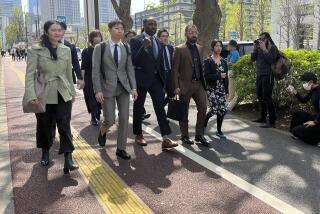Japan’s ‘Outcasts’ Caught in 21st Century Prejudice
- Share via
TOKYO — A daughter’s engagement is a time of joy for any proud father, but not for Ikuo Aoki. His daughter was thrown out of her boyfriend’s family home when the young couple went to announce their plans to marry.
The reason was unstated but well-understood: Aoki is a descendant of Japan’s former “burakumin” outcast class, a distinction that has brought his family a lifetime of ridicule, discrimination and abuse.
“I almost rushed over to their house to condemn them, but I didn’t because her boyfriend was still considering marrying her,” said Aoki, 68. His restraint made no difference; the couple eventually broke up.
Ethnically identical to other Japanese, burakumin suffered for centuries at the bottom of the feudal hierarchy, digging graves, chopping meat and performing other jobs associated under Buddhism and the native Shinto religion with the impurities of death.
In recent decades, the former untouchables have made vast strides. Their slums have been cleaned up and education levels have risen. Many burakumin quietly blend into the rest of society, marrying outside their caste and taking on mainstream work.
But more than a century after Japan’s caste system was abolished, in 1871, burakumin still face the injustice of bigotry -- scuttled engagements, the taunts of strangers, rejected job applications.
“There has been some progress,” said Takao Yoshida of the Buraku Liberation League, Japan’s largest outcast rights group. “But you face discrimination whenever you’re at life’s turning points, such as marriage and employment. You just can’t avoid it.”
Known in the feudal period as “filth” or “non-human,” the outcasts were legally trapped below the castes of the warriors, artisans, farmers and merchants, which were themselves ranked in that order. Burakumin had to follow a dress code and were restricted to living in special hamlets.
Even after the caste system was outlawed, bias kept burakumin largely confined to their own villages, and they were easily singled out for abuse based on address.
It still happens. Japan’s family registry keeps a file on every citizen’s background going back generations, allowing potential marriage partners or employers to uncover burakumin origins.
Such discoveries have torpedoed many marriages and job applications, activists say.
“We have the same skin color and we speak the same language, so the burakumin discrimination is difficult to understand from outside Japan,” said Satoshi Uesugi, a historian at Kansai University in Osaka. “It’s because Japanese judge others by bloodline and birthplace.”
About 900,000 Japanese with burakumin background lived in 4,442 ancestral villages in 1993, according to the most recent government survey. Rights groups estimate 2 million more live outside their hamlets.
After decades of civil rights protests, the government enacted integration laws in 1969 to improve living conditions in the burakumin hamlets. The project upgraded housing, roads and education until 2002, when the government said it had done enough.
Burakumin, however, say more work remains. In a society that puts a premium on conformity, the stigma of being in a community that lived apart from -- and below -- the Japanese mainstream for centuries has been hard to erase.
More to Read
Sign up for Essential California
The most important California stories and recommendations in your inbox every morning.
You may occasionally receive promotional content from the Los Angeles Times.













